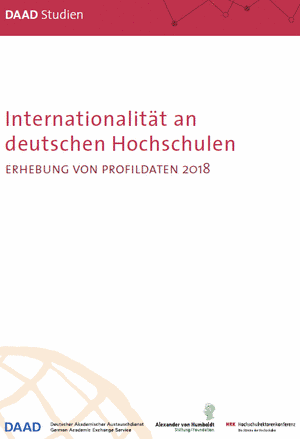Stay in the loop! Subscribe to our mailing list

Since 2010, Germany’s DAAD, the German rectors’ conference (HRK), the Alexander von Humboldt Foundation (AvH) and the country’s research council (DFG) have been publishing annually a set of ‘profile data’ to identify international activities in the country’s higher education system and to measure progress in the degree of 'internationality'. The report for the year 2018 has now been published. It was produced by the Gesellschaft für empirische Studien (Kassel) and funded by the Federal Ministry of Education and Science. The report is based on the analysis of data which the above organisations and Germany’s statistical office (Destatis) annually collect.
The report measures the degree of internationality by means of eight parameters, i.e. the number of inbound mobile international degree students; the number of inbound and outbound ‘mobilities’; the amount of funding received from the DAAD; the number of English-taught degree programmes; international cooperation activities outside of Erasmus; the number of foreign researchers in German higher education; AvH scholarship holders and award winners; and EU funding. Even though the data allow to create the international profile of each German higher education institution (which separately receives its own profile), the study presents the data only by types of higher education institutions and thus in anonymised form.
For 2018, the report concludes that the upward trend in the degree of ‘internationality’ of the past years continues. Here are some examples.
20.5% of all first-year students were Bildungsausländer, i.e. foreign nationals who had received their prior education outside of Germany. The Bildungsausländer share of total enrolment was 9.9%. Both values are the highest in the years since the report was started. The share of foreign nationals among all academic staff rose to 12%, that of professors stood at 6.8%. Again, both values are the highest since the start of the exercise. The share of outbound Erasmus students ranged between 9.1% of all students at large universities and 4.5% at large Fachhochschulen. There were 1 210 English-medium degree programmes, i.e. a share of 7.3% of all degree programmes. Across indicators and parameters, small-size universities and small-size Fachhochschulen enjoy the biggest growth in ‘internationality’.
The German Ministry of Education and Research has provided funding in 2019 to expand the project. Currently, an online portal is being developed that will allow easy and more flexible access to the data. At the same time, several new indicators will be incorporated into the data set, e.g. data related to the internationalisation of research activities. The initial version of the online portal is expected to go online in early 2020.
Link to the full report (in German, with executive summary in English)